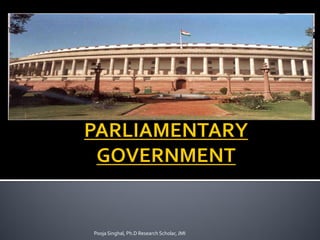
Parliamentary government
- 1. Pooja Singhal, Ph.D Research Scholar, JMI
- 2. The division of power between the state government and and the centre or union government UNION GOVERNMENT STATE GOVERNMENT POWER Pooja Singhal, Ph.D Research Scholar, JMI
- 3. • Consist of issues of national concern. Ex UNION LIST : Currency, Defence • Only union govt can make laws. • Consist of issues of state concern. Ex : STATE LIST Housing, transport • Only state govt can make laws • Consist of issues common in both the CONCURRENT list. Ex : Education LIST • Both the govt can make laws Pooja Singhal, Ph.D Research Scholar, JMI
- 4. India is a republic The head of the Indian union is the president It comprise of council of minister The ministers are collectively responsible Following British pattern India has adopted the parliamentary form of government Pooja Singhal, Ph.D Research Scholar, JMI
- 5. The founding fathers chose the parliamentary form of government as they gained some experience of operating it under British rule Further there were advantages in continuing the established institutions It was best suited to accommodate varied interest of India Pooja Singhal, Ph.D Research Scholar, JMI
- 6. Union legislature is also known as “PARLIAMENT” The parliament consist s of the president, the council of states i.e Rajya Sabha and the house of people i.e Lok Sabha The members of both the houses is known as MPs or members of the parliament The parliament has to meet at least twice in a year Pooja Singhal, Ph.D Research Scholar, JMI
- 7. LOK SABHA RAJYA SABHA It is also known as lower It is also known as upper house house It is green in color It is green in color It consist of 550 members It consist of 250 members Members are directly Members are directly elected elected To become its member To become its member the person must be 25ys the person must be 25ys of age of age Presiding officer is Presiding officer is vice- speaker president Pooja Singhal, Ph.D Research Scholar, JMI
- 8. LOK SABHA RAJYA SABHA Pooja Singhal, Ph.D Research Scholar, JMI
- 9. Can you list few differences in the powers of Indian president & U.S President? Pooja Singhal, Ph.D Research Scholar, JMI
- 10. Election Commission is an independent body that conduct elections It performs the following functions: Fix the date Mark Electoral constituencies rolls Polling boots, Declare voting machines results Pooja Singhal, Ph.D Research Scholar, JMI
- 11. RULING PARTIES: A party secures the majority of seats in the parliament OPPOSITION PARTY: The party in opposition. They act as a check on the ruling party by criticising its policies Pooja Singhal, Ph.D Research Scholar, JMI
- 12. POWERS Power of making laws Putting laws into action Control over finance Power to provide justice Making few changes in the constitution Pooja Singhal, Ph.D Research Scholar, JMI
- 13. FIRST READING SECOND READING THIRD READING BILL IN OTHER HOUSE PRESIDENT’S ASSENT Pooja Singhal, Ph.D Research Scholar, JMI
